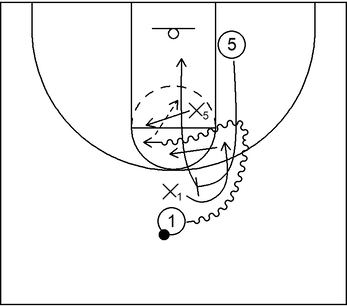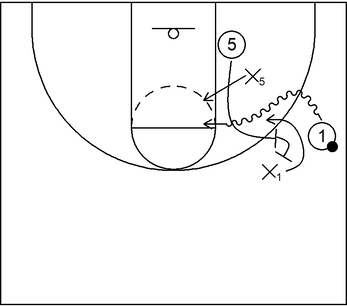What is a basic definition of the snake dribble in basketball
The snake dribble consists of action that occurs when an offensive player in possession of the basketball momentarily dribbles toward the basket via an on-ball screen but afterwards, that same offensive player swiftly turns and dribbles in a lateral direction, which could eventually lead to a possible scoring opportunity.
Essentially, the offensive player dribbles the ball in a somewhat winding pathway that would be similar to a snake’s slithering movement, hence the name of snake dribble.
Which basketball positions utilize the snake dribble
In terms of basketball positions, the snake dribble is typically executed by the point guard but it could also be utilized by other perimeter players such as the shooting guard or the small forward, especially if those players have a general understanding of fundamental dribbling concepts.
In addition to that, post players such as the power forward or center would usually roll to the basket after the snake dribble action.
Nevertheless, if those same post players possess fundamental shooting skills, then it is also possible for them to pop out near the perimeter areas of the court, which could potentially result in mid-range or three-point jump shot scoring opportunities.
Why is the snake dribble potentially effective
The snake dribble is potentially effective because it could be utilized as a basic counter to drop coverage if the screener’s defender stays below the on-ball screening action or as a step-up re-screen counter if the opposing team implements the ice defense tactic.
Potentially beneficial against drop coverage
To provide a basic example of snake dribble action vs. drop coverage, let’s say that there is a 2-on-2 situation that features an offensive point guard and center as well as a defensive point guard and center, who also execute elementary man to man defense.
Furthermore, the offensive point guard has possession of the basketball at the top while being guarded by the defensive point guard. Moreover, the offensive center is initially near the right side low post block and the defensive center is in front of the basket to protect the rim.
Afterwards, the offensive center lifts towards the top to set a basic on-ball screen near the defensive point guard’s left side, which could also help the offensive point guard dribble towards the right side.
However, as that happens, the defensive center only lifts slightly towards the nail area near the free throw line.
In other words, the defensive center executes drop coverage, primarily to mitigate or totally eliminate a potential scoring opportunity if the offensive center were to roll to the basket with the added bonus of hindering dribble penetration of the offensive point guard.
Following that action, the offensive point guards dribbles the ball with the right hand at least one time towards the basket while using the on-ball screen set by the offensive center.
At the same time, the defensive point guard fights over the top of the screen and begins to chase after the offensive point guard.
As that happens, the offensive point guard reads the situation and notices the drop coverage tactic employed by the defensive center as well as the chase behind pressure from the defensive point guard.
Those particular actions implemented by the defensive point guard and center could heavily influence the offensive point guard to execute a right to left standard crossover dribble while turning laterally towards the left side high post elbow area, which also completes the snake dribble.
When that occurs, the two defenders would almost certainly be at a disadvantage in at least a couple of ways:
First, the defensive point guard would not be able to effectively contain the ball because that particular defender would be behind the offensive point guard following the on-ball screen action.
This is further exacerbated once the offensive point guard turns their body in such a way that essentially forces the defensive point guard to take a longer route to get back in front.
As a result, the defensive point guard would be out of the play and would not be able to offer solid defensive action if the offensive point guard were to take a mid-range jump shot or if the offensive point guard were to simply pass to a teammate for a possible scoring opportunity near the basket or near the perimeter areas of the court.
Second, the defensive center would be more or less forced to either contain the ball that is in the hands of the offensive point guard or continue to hover near the middle of the high post or lane with the standard drop coverage.
If the defensive center decides to contain the ball that would be in the hands of the offensive point guard, then the offensive center would more than likely have an easier time rolling to the basket.
Essentially, if the offensive point guard dribbles laterally towards the left side high post elbow during the snake action, then the defensive center would also have to slide laterally towards that area to stay in front.
When that happens, it would create too much space between the two center players. As a result, the offensive center could more effectively roll to the basket and would not necessarily have to worry about being impeded by the drop coverage.
This would be even more of a factor if the defensive center possesses below average foot speed which makes it difficult to recover in time to slow down or prevent the roll action of the offensive center.
Also, as a side note, if the defensive center is implementing the drop coverage, then there is at least a moderate chance that player does indeed have less than ideal foot speed.
Additionally, if a defensive center with slow feet does attempt to contain the ball, then in certain instances, the offensive point guard could simply blow by them with a straight line drive and score via a layup or dunk.
Conversely, if the defensive center decides to continue with standard drop coverage to potentially take away roll action of the offensive center, then the offensive point guard could simply raise up and take a mid-range jump shot.
As a real life example of that, NBA point guard, Chris Paul generally executes snake action, especially if the screener’s defender stays back in the drop coverage. Afterwards, he usually follows up with a mid-range jump shot.
Related: Chris Paul snake dribble – YouTube
Related: Chris Paul – Pick & Roll – Snake Dribble Fadeaway – YouTube
Possibly useful against ice defense
In terms of a basic example of snake dribble action against ice defense, let’s once again establish a 2-on-2 situation that features an offensive point guard and center as well as a defensive point guard and center.
In addition to that, the offensive point guard has possession of the basketball near the right side wing while being guarded by the defensive point guard.
Moreover, the offensive center is initially near the right side low post block and the defensive center is in front of the basket to protect the rim.
After that, the offensive center lifts towards the right side wing to set a side screen near the defensive point guard’s right side, which could also help the offensive point guard dribble towards their left.
As that happens, the defensive center stays below the on-ball screen, only slightly lifting towards the mid-post extended area, particularly between the three-point line and the right side lane line.
At the same time, the defensive point guard executes ice defense by jumping above the side screen to completely take away the dribbling pathway towards the left.
From that point, to counter the ice defense, the offensive center establishes a re-screen in the opposite direction.
Therefore, the offensive center flips the side screen into a step-up screen near the left side of the defensive point, which also gives the offensive point guard an opportunity to go right.
Following that, the offensive point guards dribbles the ball with the right hand at least one time towards the baseline while using the on-ball screen set by the offensive center.
Simultaneously, the defensive point guard fights over the top of the step-up screen and begins to chase after the offensive point guard.
As that happens, the offensive point guard reads the situation and notices that the defensive center stays below the screen, similar to the standard drop coverage, as well as the chase behind pressure from the defensive point guard.
From there, the offensive point guard could execute a right to left standard crossover dribble while turning laterally towards the right side high post elbow area, which also completes the snake dribble action.
Once again, the two defenders would most likely be at a significant disadvantage. The defensive point guard would be out of the play, at least momentarily. Also, the defensive center mainly has two options.
The first option is to impede the roll action by staying between the offensive center and the basket but give up the potential mid-range shot to the offensive point guard.
The second option is to slide laterally with the offensive point guard to possibly contest a jump shot but give up a potential scoring opportunity near the basket for the offensive center.
What are simple diagram examples of snake dribble action
Example 1

This is a very simple example of snake dribble action that could occur when the ball is initially at the top. To start, 1 dribbles toward the basket with the right hand via a basic on-ball screen set by 5.
As that happens, X5 stays below the screen in drop coverage while X1 fights over the top of the screen and chases behind 1.
Next, 1 executes snake dribble action towards the left side high post. X5 decides to slide laterally with 1 to not give up the possible mid-range jump shot.
After that, 5 rolls to the basket, receives the ball from 1, especially by way of a pocket pass, and scores at the rim with a layup or dunk.
It should also be noted that the offensive player who set the on-ball screen (in this case, that would be 5) should generally roll to the basket after the offensive player in possession of the ball (for this case, that would be 1) performs the snake dribble action.
Example 2

This is a very simple example of snake dribble action that could happen when the ball is near the right side wing. To begin, 5 lifts high to set a side screen for 1.
Furthermore, X5 stays below the screen to take away a potential roll to the basket following the screening action. Additionally, X1 jumps above the screen with ice defense. Once that occurs, 5 counters with a step-up screen.
Therefore, 1 initially dribbles at least one time with the right hand towards the baseline while X1 fights over the top and chases behind.
Afterwards, 1 turns and performs snake dribble action towards the right side high post area. From there, X5 could try to contain but 1 would most likely be able to raise up for a mid-range jump shot before either X1 or X5 could completely contest with a hand in the face of 1.
Related: Snake – The Basketball Dictionary